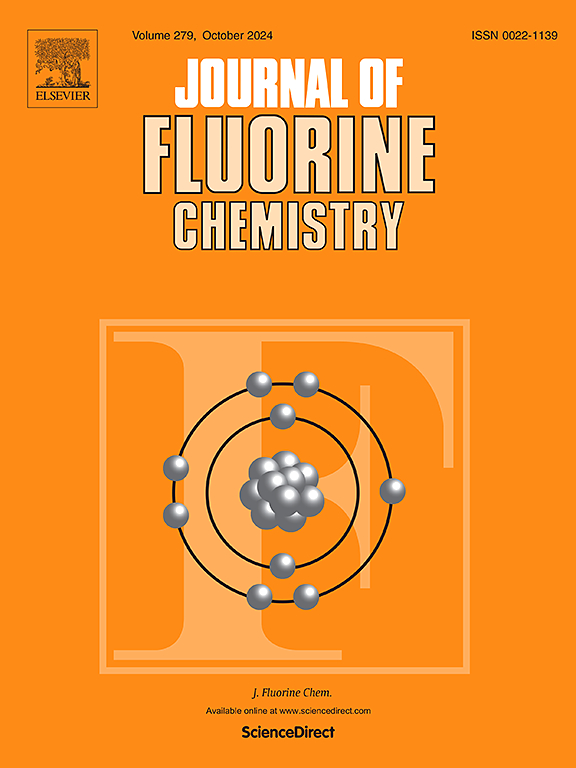阿片配体的五氟化醇支架
IF 1.7
4区 化学
Q3 CHEMISTRY, INORGANIC & NUCLEAR
引用次数: 0
摘要
Me3SiCF2CF3与morphinan衍生物vinal(10)的羰基加成反应,然后氧化生成的C(20)-外聚二次醇(20R)-11a和(20S)-11b(15:1)的混合物,首次制备了五氟化酮12。后者有望作为一种起始化合物,用于制备醇醇和鸟苷醇,这两种假定的阿片受体配体在其C(20)中心药效团内五氟化。结果表明,MeLi和MeMgI确实加入到酮12的羰基上,形成以20r -异构体为主的C(20)-外聚叔醇和五氟乙基醇的混合物。酮12与LiAlH4的还原也会生成C(20)-外聚体五氟醇(20R)-11a和(20S)-11b的混合物,但外聚体的比例(1:8)与醛10与Me3SiCF2CF3反应的比例相反。本文章由计算机程序翻译,如有差异,请以英文原文为准。

Pentafluorinated thevinol scaffold for opioid ligands
An addition reaction of Me3SiCF2CF3 to the carbonyl group of thevinal (10), a morphinan derivative, followed by an oxidation of the resulting mixture of the C(20)-epimeric secondary alcohols (20R)-11a and (20S)-11b (15:1) resulted in the first preparation of the pentafluorinated ketone 12. The latter is expected to serve as a starting compound for the preparation of thevinols and orvinols, putative opioid receptor ligands pentafluorinated within their C(20)-centered pharmacophore. It was shown that MeLi and MeMgI, indeed, add to the carbonyl group of ketone 12 to afford the mixture of C(20)-epimeric tertiary alcohols, pentafluoroethylthevinols, with the 20R-isomer predominating. The reduction of ketone 12 with LiAlH4 also results in the formation of a mixture of the C(20)-epimeric pentafluorothevinols (20R)-11a and (20S)-11b However, the ratio of the epimers (1:8) is opposite to that one obtained from the reaction of aldehyde 10 with Me3SiCF2CF3.
求助全文
通过发布文献求助,成功后即可免费获取论文全文。
去求助
来源期刊

Journal of Fluorine Chemistry
化学-无机化学与核化学
CiteScore
3.80
自引率
10.50%
发文量
99
审稿时长
33 days
期刊介绍:
The Journal of Fluorine Chemistry contains reviews, original papers and short communications. The journal covers all aspects of pure and applied research on the chemistry as well as on the applications of fluorine, and of compounds or materials where fluorine exercises significant effects. This can include all chemistry research areas (inorganic, organic, organometallic, macromolecular and physical chemistry) but also includes papers on biological/biochemical related aspects of Fluorine chemistry as well as medicinal, agrochemical and pharmacological research. The Journal of Fluorine Chemistry also publishes environmental and industrial papers dealing with aspects of Fluorine chemistry on energy and material sciences. Preparative and physico-chemical investigations as well as theoretical, structural and mechanistic aspects are covered. The Journal, however, does not accept work of purely routine nature.
For reviews and special issues on particular topics of fluorine chemistry or from selected symposia, please contact the Regional Editors for further details.
 求助内容:
求助内容: 应助结果提醒方式:
应助结果提醒方式:


